
Mountain Equipment Aiguille Hooded Top
A "long-sleeved t-shirt with attitude", this light, stretchy and breathable mountain top has found a niche in his wardrobe that Dan Bailey didn't know he needed to fill. Shame about the cut, he says.
When you want some protection from the elements, but a full shell would be overkill and a softshell too warm, a thin windproof is the obvious choice.
These tops (we hesitate to call all of them jackets) are unsurprisingly popular with runners, since they're light and packable enough to squeeze into a bumbag or running vest, and (ideally) sufficiently breathable to be worn on the move. But a layer like this can be just as useful for hillwalking, scrambling, crag walk-ins and even climbing on a breezy day. From mountaineering to weight-conscious backpacking, a windproof takes up minimal pack space, so it's not a chore to carry just in case you need to give your layering a quick boost. In fact we reckon these tops are some of the most versatile and useful of all outdoor clothing.
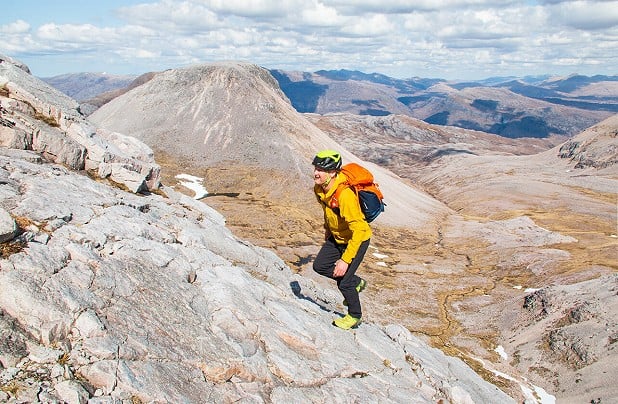
Here we look at nine windproofs from seven different brands. The selection offers something for everyone. A couple are best described as ultralight just-in-case layers better carried than worn - including what's claimed to be the world's lightest windproof. Some are breathable and slim-fitting for runners, while others are better all-rounders that should appeal to walkers and climbers too.
What are we looking for in this review?
Fabric
Keeping off the wind is obviously the primary job, and if there's a DWR to help shrug off light moisture too then we'd consider that a definite advantage for use in mixed weather. But breathability is also vital. If you're moving, and working up a sweat, you don't want to feel like you're wearing an impermeable plastic bag - something that a couple of the tops in this review do unfortunately suffer from.
Weight and durability
In the case of a windproof, light is clearly right, but it's possible to take this too far since thinner fabrics can be prone to damage. While specialist users may go all-out for lightness and accept a compromise on a windproof's longevity, your average generalist might be happy to carry a few extra grams if it means a tougher top that'll take at least a degree of abuse. This will probably go double if you're aiming to climb or scramble. Ultimately all of the options on test are pretty darn light, and none of them are built particularly tough, so we're talking fine margins of difference.

Fit
Running-oriented windproofs will tend to be slim-fitting to cut down on excess fabric and flapping, but may as a result offer slightly limited arm movement for climbing. If you're intending on using it for climbing then try it out for freedom of movement, and watch for hem lift when your arms are raised. Windproofs aren't just for summer: a more generous cut will allow for some extra layering underneath, increasing the seasonal relevance.
Features
By definition a lightweight windproof ought to be pretty simple, but one or two features are worth looking at. Is there a zipped pocket, can it double as a stow pouch, and if so is there a tab to hang it off a harness? For colder, windier weather, some people will like to have the option of a hood; others - perhaps particularly runners - may rarely if ever use a hood on a layer like this, preferring the simplicity of a hoodless collar. There is no definitive answer on hoods, and we're conflicted even among the gear team, but it's something to think about when choosing a windproof for your own needs.

Value?
There isn't much to a windproof. Prices over about £100 are hard to swallow, so however good they may be in other respects we have not awarded more expensive models a Highly Recommended rating in this group test.
| Make and model | |
|---|---|
|
Montane Price: £75 Weight: 110g (size not specified) Pros: Light-ish, pretty breathable, simple, and fairly priced Cons: Not cut for climbing; no hang loop |

|
|
Rab Price: £80 Weight: 115g (size M) Pros: Great active cut and supremely breathable; the price is good too. Cons: Mesh back panel is pretty specialist - nice when sweating but cold if you're stationary |

|
|
Black Diamond Price: £130 Weight: 98g (size not specified) Pros: High-tech eco-friendly fabric; lightweight Cons: Pricey, not the most windproof (good if you're running, not if you're not) |
|
|
Dynafit Price: £125 Weight: 94g (size not specified) Pros: Very light and packable, but not flimsy; good breathability Cons: High price; tight and short for the size; no pocket; breezy back if you're stood still |
|
|
Mountain Equipment Price: £100 Weight: 120g (size not specified) Pros: Soft, breathable fabric. Cut for climbing, and has a stow pocket Cons: Neither the lightest nor the toughest; we'd have preferred a hood-less version |

|
|
Mammut Price: £120 Weight: 149g (size M) Pros: Great all-rounder; long cut makes it a decent option for climbing Cons: Relatively pricey; heavy compared to some |
|
|
Black Diamond Price: £150 Weight: 48g (size not specified) Pros: Super-duper-mega-light emergency layer Cons: Extremely costly and barely breathable |
|
|
Montane Price: £80 Weight: 60g (size not specified) Pros: Superbly light, but not flimsy; competitive price Cons: Cut tight and short |

|
|
Marmot Price: £120 Weight: 156g (size not specified) Pros: A bit tougher and more versatile than some Cons: Pricey, relatively heavy; not the most breathable for high aerobic activity |
Reviewed by Dan Bailey UKH 
Wind-resistant but pretty breathable for a windproof, the Featherlite Trail Jacket has a well-thought-out design with several useful features, yet the overall weight has been kept sensibly low, and the price seems more than fair too. Spot on for runners, it's also a great choice for lightweight backpacking and fair weather hillwalking. Aside from a cut that doesn't really favour climbing, this model is hard to fault. A cheaper half-zip smock version is also available, but we think the full zip 'jacket' reviewed here is the more versatile.
Weight
At 114g in size Large (Montane say 110g, size not specified) the Featherlite Trail Jacket might not be in the realms of the superlight tops covered below in this review, but we think it's got to be light enough for all but the most exacting users. Despite its relatively low weight, this jacket doesn't feel unduly flimsy, and should be up to regular wear, not just occasional emergency use. It's not completely spartan either, and you still get a few welcome features.
Fit
The Featherlite Trail Jacket (though not the half-zip alternative) is available in a women's version as well as the men's. The cut is about medium length, sitting below the waist to keep the wind off your midriff, and providing at least a bit of bum coverage. A close fit in the body suits the active remit - you don't want spare fabric billowing around when you're running - but does limit your cold weather layering options. While I can fit it over a baselayer and a midlayer fleece, it does feel a bit squeezed, and ideally I prefer to wear it straight on top of my t-shirt. Think summer use, not winter on the hills.
While the underarms feel quite roomy, I find it much tighter in the forearms - you could even say restrictive, especially with a bent elbow. I I struggle to push the sleeves up over my forearms (something I like to be able to do to help keep cool on the move), though someone with more of a stereotypical skinny runner's build and less of a chunky upper body might find this less of an issue. I also get quite a bit of hem lift with raised arms, something that's clearly sub-optimal if you're scrambling or climbing. Overall I'd say the fit is tailored a lot more towards running and walking than climbing.
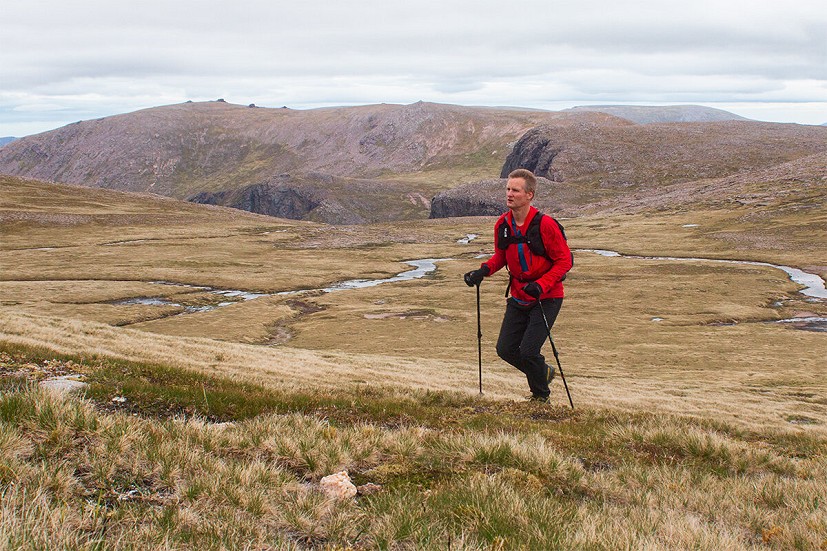
Fabric
Its Wind Barrier Dynamic fabric is perhaps one of the key selling points of the Featherlite Trail Jacket. Quick-drying and shower-shedding (thanks to its DWR), this 20 denier nylon feels really quite windproof for its thinness, but unlike some other jackets on test this doesn't mean you have to sacrifice any pretence at breathability, and even in relatively benign conditions I've found I remain comfortably un-clammy most of the time. Work really hard and you can exceed the fabric's ability to breathe, but any moisture that builds up inside does seem to dissipate rapidly. If you want a windproof to run in, not just to carry for emergencies, then this is one of the better choices on review.
A small degree of stretch in the fabric helps a bit to mitigate the rather close fit, and while it's certainly not going to last long unscathed if you're often out scrambling or climbing, for its lightness I think the fabric does seem durable enough.
Features
The Featherlite is suitably simple, but not a total minimalist. You get a single smartphone-sized zipped chest pocket; handily this doubles as a stuff sack, but less usefully there's no carrying loop, so you'll have to improvise if you want to clip it to your harness.
A hem drawcord with a single toggle helps keep the fit trim at the waist, while the stretch-bound sleeve cuffs feature thumb loops to keep the wrists and back of the hands covered if there's a cold breeze.
The mid-height collar offers a degree of neck coverage, though if it's cold and windy you may want to add a Buff to cover the rest. There's no hood, and for me this is an advantage on a lightweight layer like this since the limited protection such a hood could offer would be outweighed by having it flapping around unused most of the time.
For maximum ventilation, the light-gauge full-length front zip makes the jacket more versatile than the half-zip smock design, while the internal wind strip helps keep the breeze at bay. Extra airflow is provided by a series of small open vents under each arm. These slits feel pretty effective when you're running and working up a sweat; and they're not going to let much weather in unless you're spending a lot of time with your arms raised - which is another reason the Featherlite is better for runners and walkers than climbers.
Some reflective detailing should help make you visible if you're out on a road at night.
View website
Reviewed by Rob Greenwood UKC 
Aimed at those who are on the move, the Windveil Pull-On is designed with running in mind, although could equally be used for walking. Its mesh back means that it offers much more ventilation, which makes it a very breathable jacket; however, the catch to that is that compared to many others on review it's a whole lot less warm. The windproofing throughout the body does provide protection though, particularly when you're on the move, but due to the mesh it'll feel a lot cooler once you stop. As a result of this, it's not something I'd wear whilst sat at a belay. But for running it's absolutely spot on.
Weight
At 115g it's light, but not super light. This is a jacket that's designed to be worn, as opposed to being stored in the bottom of your rucksack 'in case of emergency', so its weight feels perfectly balanced with its intended use.
Fit
Coming in both men's and women's fit, the Windveil Pull-On has an active, slim-fitting cut, but still with excellent freedom of movement. There's minimal hem lift whilst raising your arms, which makes it an ideal choice for technical terrain, although perhaps this isn't overly surprising given its place within Rab's Skyline range, which is designed with sky running (running/scrambling/climbing) in mind. It's also got a nice, long set of arms (short arms are a pet hate of mine!), with an elasticated cuff that can be rolled up to the elbow in warmer conditions.
One final (and fairly major) bonus to the fit of the Windveil is that it's designed to be worn both under and over a running vest. The stretch panel on the back means that it's possible to do this without the fit being overly tight or restrictive, which is a huge plus on days where you're unsure if you want it on or off.
Fabric
Pertex Quantum Air is featured throughout the body, shoulders and arms. This is super stretchy, super light and super comfortable against the skin, as it actually has some texture - it's not like a plastic bag. While any windproof is worth being a bit careful with, at 20D the fabric is tougher than some of the really skimpy stuff on review, and on the whole I've been impressed with how durable it's been - despite some close encounters with sharp rocks. If you do end up ripping it, Rab's repair service is always there to provide a solution.
Throughout the back and underarms you've got a 'Motiv Aero single jersey fabric with mesh structure', which I've thus far referred to as 'mesh'; however, a far more accurate way of describing it would be as a base layer fabric, as it's the exact same material Rab use on their Sonic Tee. This provides excellent air flow and dries extremely quickly, but does - as per the intro - mean that it is substantially cooler than your average windproof, since it's not actually windproof.
One major benefit to the use of this fabric is that the stretch it provides allows you to use the Windveil over a running vest, which is a massive plus for more committed runners who are looking to save time on more marginal days.
Features
There aren't many features on the Windveil Pull-On, but the two we can think of are simple, uncluttered and unobtrusive. At the back, there's a small pocket which doubles as a stuff sack. I've tended to use this to store keys, cards or gels. At the front, there's a small press stud part way down the zipper. These are integrated within quite a few jackets these days and when I first saw them I wondered about whether they were genuinely effective. Having used them on windy days, where you want the zip open to vent, but don't want a load of material flapping around, I've decided the press stud is a simple and elegant solution to prevent that from happening. Not many tops in this review have this feature, so that's a plus to the Windveil.
View website
Reviewed by Dan Bailey UKH 
Very light, and probably about as water-resistant as a windproof gets, the Distance Wind Shell is great for running and also a good choice for fair weather hillwalking, or backpacking. If the fit works on you whilst climbing then it'd be a good top for mountain rock days too. It has an interesting DWR finish that's claimed to be both more environmentally friendly and more durable than standard DWRs. The air permeable fabric isn't too sweaty when you're working hard, but I do think it feels a bit less windproof as a result. It's not cheap either, and the price costs it a Highly Recommended rating in this group test.
Weight
At only 95g in my size L (BD say 98g, size not specified) the Distance really is an lightweight top, which has to be a good thing in a windproof layer. Stowing neatly in its own pocket, which has a hang tab for attaching to a harness, it packs so small that you'd barely notice it in your running vest, or hanging from a gear loop while climbing.
Fit
The Distance Wind Shell comes in both men's and women's models. As often seems to be the case with North American brands, the sizing is a bit more generous than UK-designed clothing; I'm 183cm tall and reasonably thickset, and in my usual size L there's a lot of spare volume. It's by no means the slim fit that BD claim. I could probably have got by in a Medium, especially considering that with a thin garment like this that's most likely to be worn over just a couple of light layers - perhaps only a T-shirt when running - you'd ideally want a closer cut.
But it's not all bad since in cooler conditions - windy spring and autumn days on the hills for instance - the benefit of the extra space is that you can fit a bit more insulation underneath. Unsurprisingly, in my size there's plenty of length in the hem, which helps keep draughts off your midriff, and the sleeve length is similarly generous. The elasticated cuffs fit easily over gloves.
Arm movement is unrestricted, but despite this I don't think the cut is that climbing-friendly, since I get significant hem lift with my arms raised, and it's very prone to pulling up out of a harness. Perhaps this is in part thanks to the fact that the fabric is so smooth and shiny. On the other hand, the hood on the Distance Wind Shell is one of the few on test that genuinely fits over a climbing helmet, with minimal restriction. In fact I'd say the hood works better when stretched over a helmet than it does without this added structure. Its one point of adjustment isn't enough to get a proper seal around the face, and with its soft brim it's very prone to flapping and catching the wind. This is ironic at best, in a windproof. The hood can't be secured when not wanted, which is a bit annoying when running, and on balance I'd have preferred a hood-free design.
Fabric
At 30gsm, the 15D ripstop Nylon feels really thin and light, in fact almost translucent, but it still seems to be pretty tough for its weight. However after only moderate use of a few months some stitching on one of the wrist cuffs is already unpicking, and I don't think the build quality inspires quite as much confidence as the tops I've looked at in this review from Montane and Mountain Equipment. Being so insubstantial it's quite flappy in the breeze even by the standards of a lightweight windproof, and this may help explain why I don't feel quite as well protected from the wind as in some other models on test. The fabric's air permeability is also partly responsible for the less protected feel, but of course the upside to this should be enhanced breathability. I've certainly found it pretty good in that respect, and in cooler weather I can run or walk hard uphill in comfort, without getting too clammy inside.
Light drizzle is no problem, thanks to a water-free and PFC-free DWR that's claimed to be superior in performance to other DWRs. Being permanently 'hyper-fused' to the individual fabric fibres, this treatment is also supposed to be substantially more durable than standard DWR, and Black Diamond say it should never need to be re-treated in order to maintain its performance. This is potentially a bit of an innovation, since even if you buy the most eco-friendly treatment products you'd have to assume (manufacturing aside) that it's more sustainable not to have to reproof a garment at all. I've not yet had the Distance Wind Shell long enough to verify its longevity.
Features
Its single small chest pocket is just enough to hold a phone, and doubles as a harness-hanging stow pouch. Aside from this all you get is one elastic adjustment toggle at the waist, with the spare end sensibly directed up inside the hem so it shouldn't get in the way.
View website
Reviewed by TobyA 
Dynafit are well known amongst ski mountaineers for their boots and touring bindings. Skimo racing has expanded significantly in the last decade and has led to amazingly ultralight kit and clothing. This has spread to Dynafit also becoming a leading brand among trail, ultra and mountain runners and the Alpine Wind Jacket comes very much from that ultralight, fast-paced world. A full zip hooded jacket, the Alpine Wind gives impressive amounts of protection for a ridiculously low weight and compact size. Windproof, drizzle-resistant and with a hood for extra protection, it's a good jacket for moving fast (or just steadily) in relatively bad weather.
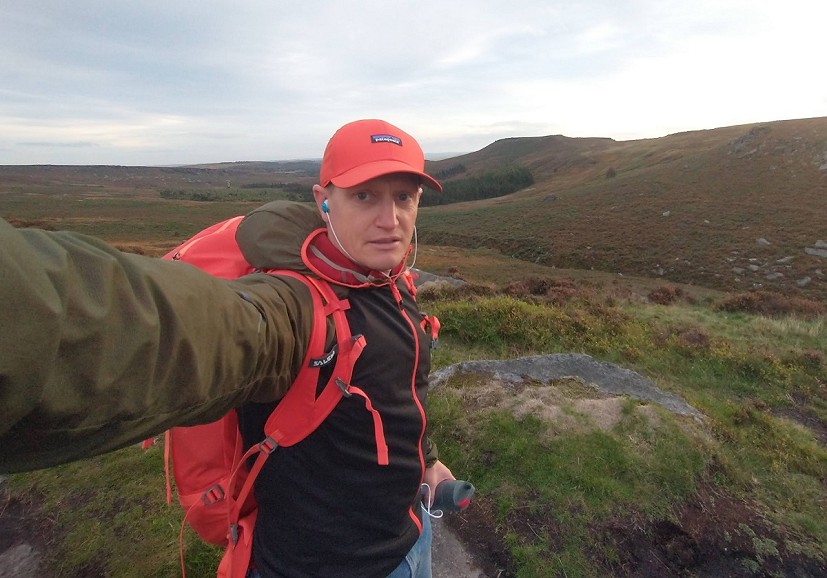
The RRP is £125, which is expensive compared to at least some of the competitor products. The price costs it a Highly Recommended rating in this group test, but in other respects we really like it.
Dynastar have certain colours of the jacket available on their website for £87, but looking from a UK IP address leads to the dreaded pop-up apologising that, due to Brexit, the webshop is currently closed to people in the UK, so I'm not sure who can buy them for the reduced price - another example of taking back control? Dynafit is part of the Oberalp conglomerate and all their brands' webshops seem to have been showing similar messages since January 2021, so presumably direct sales are not going to be available for quite some time, as no solution has been found so far.
Weight
Dynafit's website says 94g (not specifying what size of jacket). My size medium jacket weighs 94g on one set of scales and 95g on my other set, so I think Dynafit are pretty spot on with their stated weight. This is very impressive for a hooded jacket, and although Dynafit do make an even lighter hooded windshell called the Vert Wind at a measly 72g, in the real world the Alpine Wind jacket is going to be easily light and packable enough for most people.
Fit
Dynafit describes the cut as 'athletic' and 'slim'. Neither are words I would immediately reach for to describe myself. I hasten to add I'm not actually fat, and normally fit "medium" fine for most outdoor clothing, but the Alpine Wind does have a noticeably slim fit, particularly around the midriff; it's also a bit shorter in the hem than some alternatives, which is potentially a disadvantage. However I find there is enough room for my relatively broad chest and shoulders, plenty of length in the arms, and the articulation for arm movement is excellent. I can wear the Alpine Wind over a base layer and a fitted, hooded microfleece without it feeling constricting. I have rock climbed in this top and ridden both mountain- and drop-bar bikes in it with no problems with reach. I'm 175cm tall, but slim folks who are considerably taller than me would fit medium I suspect - the athlete model wearing the medium jacket on Dynafit's webpage is 189cm tall for instance.
Fabric
Dynafit say the material is "DYNASHELL ULTRA LIGHT COATED MINIRIPSTOP 35 (100% Polyamide)". The fabric feels decently breathable when I'm getting sweaty, while at the same time its tight weave keeps out most of the breeze. It is pleasantly textured rather than having that ultra smooth silky/plastic feeling of many windproofs, which may help explain its breathability. Obviously many runners will pull on a jacket like this over a t-shirt or even a running vest so it's quite likely to be against your skin on the arms and possibly shoulders, and it doesn't feel unpleasantly clammy when it is. And while I'm sure it's not what Dynafit had in mind when they designed the Alpine Wind, I have done a couple of solo grit climbing sessions in it. I rarely solo harder than Severe and, on grit, Diffs and VDiffs will often include chimneys and other graunchy climbing. The Alpine Wind has emerged from these semi-subterranean adventures unscathed, so I'm impressed with its strength for such a lightweight fabric.
Perhaps the most obvious feature is that the majority of the back panel is stretchy fine mesh rather than the windproof material of which the rest of the jacket comprises. For runners and cyclists on the move this makes a lot of sense for sweat management. For walkers carrying a rucksack, it will also make little difference. Perhaps if you walk or jog slowly with just a hip-pack you might experience an unpleasantly cool back with a tailwind, but so far I've not found this. The one obvious drawback with this extra-vented design is that it will inevitably be colder if you're fully stationary for any length of time - it'd be a bit crap on a windy belay for instance.
Features
Weighing under 100g it unsurprisingly doesn't have many features. The jacket doesn't have any pockets, except a tiny pouch-like feature at the neck designed for the jacket to be stuffed into. This is a fairly epic task but, if achieved, it turns the jacket into a tiny and dense ball, about the size of a small satsuma. It has some small reflective detailing on it, for night safety I guess.
Around the shoulders there are also some small "laser cut" ventilation holes. These must help get sweat out and don't seem to noticeably let cold wind in.
The hood is a trim but un-adjustable design. I find I prefer to wear it over a cap or light hat, but there is nothing wrong with it just pulled up over your head. A good feature for running is that the hood can be rolled up and secured when not needed. Nicely finished slits at the cuffs, that work as thumb loops and sometimes mean that you can get away without gloves, finish the minimal features.
View website
Reviewed by Dan Bailey UKH 
Described by Mountain Equipment as a softshell, but very much in the windproof category in terms of weight and function, the Aerofoil is one of the designs best suited to climbers, with a decent active cut and enough room to fit easily over a midlayer. While Mountain Equipment specifically bill this as a jacket for mountain rock and light/fast alpine climbing, we think it's also spot on for hillwalking, backpacking and running, and only really let down by the hood.
Weight
At 120g in a size L, and packing down pretty small into its own stow pocket (think grapefruit-sized), the Aerofoil may not be the lightest and most compact windproof on review, but it ought to be easily light and packable enough for most users. But as a result there are limits to its durability. I pulled out one end of the hem drawcord after only a few uses (I didn't even notice it happening), and have heard reports of the fabric being surprisingly easy to tear, too. This is worth bearing in mind if you'll regularly be climbing or scrambling in it.
Fit
The Aerofoil comes in both women's and men's versions. It has a slightly more generous fit than some of the more running-dedicated windproofs on test here, and I can wear mine over a baselayer and midweight fleece without feeling restricted. Hem length is good, sitting well below the waist, and thanks to the slightly more generous and articulated cut of the sleeves I can raise my arms without suffering too much lift. The hem tends to stay tucked under a harness, which is pretty much essential when climbing.
Its simple elastane-bound cuffs will fit over a light glove if necessary, and with a bit of a struggle I can just about push the sleeves up over the forearm if wanting to cool down on the move.
The hood is described as helmet-compatible, but I strongly beg to differ. It's not spacious enough to pull up over a helmet without severely limiting head movement and pulling the front hem miles up in the process. You'd be better off wearing it under your helmet in extremis, but that's still far from ideal in terms of head movement. This stretch-bound hood has a very simple rear adjustment tab (no elastic), which does give it a snug fit onto a helmet-free head, but even then with the zip done up your freedom is slightly limited. I do like the nice high collar, which helps keep wind off your neck when the hood isn't being worn. In fact, given that the hood isn't great I would rarely if ever use it, and since there's no way to secure it down I'm just left with something flappy around the back of the neck, an annoyance when running (for which, otherwise, the Aerofoil is great). On balance I'd have far preferred this as a hood-free jacket.
Fabric
Windproof enough to repel the breeze, the Exolite 45 double weave polyamide soft shell fabric still manages to be sufficiently breathable to keep you comfortably un-sweaty when moving - even running. Unlike some of the more plasticy tops on test it's not particularly loud and flappy, and doesn't feel clammy against a bare arm. There's a tiny bit of stretch to aid free movement, and a ripstop pattern that helps a bit with durability - but bearing in mind its lightness, this fabric isn't going to survive a lot of contact with rough rock. If you want something similar but a bit sturdier (albeit also heavier) for regular rock or alpine climbing, or even scrambling, then look at Mountain Equipment's Squall Jacket.
Living where I do, wind often comes with mist or drizzle. The Aerofoil easily shrugs off a bit of light moisture, and dries quickly, making it a really good all-round top that's well suited to a lot of mountain activities.
Features
It's also worth noting the chunky YKK Vislon zips; these are probably the most durable bit of the Aerofoil, and arguably a bit of overkill in terms of weight and bulk compared to the skimpier zips common to other windproofs. But the main feature is the stow pocket, which comes with two tabs for neatly and securely clipping to a harness.
View website
Reviewed by Nick Brown UKC 
The Mammut Aenergy windbreaker has trained me out of wearing more insulated layers. It's been an ideal all-rounder for cooler months when on the move. It's not a jacket for standing around in but whether running, climbing, walking, or even skiing, it provides decent protection for chilly, windy conditions. It's a relatively well-featured jacket within the review and has a cut that suits climbers. Overall it's just a great option for someone who wants a multipurpose windproof.
However it's expensive, and the price alone costs this otherwise excellent jacket a Highly Recommended rating in this group test.
Weight
At 147g, it's certainly not the lightest in this review but let's be honest, that's still pretty light by most standards. To me it hasn't once felt like a burden either to wear or to pack away and leave it in a bag. I've been running, hillwalking and climbing in this and its weight feels like a good middle ground for an all-round windproof.
Fit
Available in both men's and women's models, the Aenergy WB jacket is described as having an 'athletic fit' although we find it roomier than many of the other windproofs on test.
The cut is slightly longer than most too, which may account for some of the extra weight but also offers a bit more protection around the waist than shorter tops. The tailoring gives a decent range of movement, preventing hem lift when climbing. It's perhaps not as streamlined as an ultra-light racing top but nor is it designed to be. Since there's room for layering underneath, this top can be taken into colder conditions than most in this review, from breezy winter runs to winter ski tours.
The hood fits over a helmet, although its description as helmet compatible is a bit optimistic since it does restrict movement slightly. The cap in the hood means that it won't comfortably go under a helmet. For both climbing and running, perhaps a hood-free version might have been better.
Fabric
The Aenergy uses Pertex Equilbrium fabric. The theory behind this is the tightly woven outer layer keeps the elements at bay, whilst the inside layer wicks moisture away. I've found the jacket to be quite breathable, using it on several autumnal runs without instantly overheating or boiling in my own vapour. I wouldn't advise running in it during the warmer months but it's unlikely a jacket like this would need to come out of the bag during the summer, except for when up high or climbing.
One of the main advantages of this jacket is the durability of the fabric. At 20D it's notably thicker and heavier-gauge than some of the skimpy light-as-air competition, and for all-round users who aren't necessarily into counting every last gram, this relative toughness has to be a good thing. I've had no issue with climbing where I'm either scuffing the sleeves and arms, or when running through suspiciously sharp plantlife. So far the Aenergy has held up very well in that regard.
Unusually, Mammut have added a panel of elasticated fabric on the forearm, ostensibly to ensure an 'optimum fit'. It seems an odd place to make stretchy (versus, say, the sides of the body or the underarms) and I can't say I've noticed it offering any advantage. But it doesn't do any harm there I guess.
Features
A prerequisite for jackets like these is that they fold into their own pocket: this is no different, although it doesn't pack down quite as small as others in this review, mostly down to the extremely roomy chest pocket that it goes into.
The hood is adjusted with a single toggle at the back that tightens it around the head, giving it a very comfortable, yet snug-fitting feel. This is certainly welcome when it's blowing a gale and you want to retreat inwards and reduce flapping. The hood also has a stiffened peak which is always a decent addition for when caught out in the rain, as it helps the whole thing hold its shape and keeps some of the elements out of your eyes.
There is a two way zip that's great for use with a harness or for maintaining a bit of a cool breeze. The waist adjustment is a simple drawcord that seems to stay tight when in use.
I only have a couple of bugbears about this jacket. The first is that when running, the tab on the full length zip has a habit of whipping you in the face. This isn't the end of the world, as it's easily removable, although you'll need it on if wearing gloves.
Secondly, I'd have loved a small popper or piece of Velcro across the chest to keep the jacket together when running with the zip open. Without this, I've found that it slowly starts to work its way off the shoulders when flapping in the wind.
View website
Reviewed by Dan Bailey UKH 
Billed as the world's lightest windproof - and it's hard to imagine anything currently beats it - the Deploy is the last word in weight-saving and packability. Its barely-there 5D fabric and ultralight zip are both interesting developments, but it has to be said this is a very specialist top that's only going to appeal to a particularly dedicated sort of user - more of a statement piece than a likely bestseller. With very poor breathability, what you're getting here is in essence an emergencies-only layer, not one you'll want to wear for your regular morning run. At £150 it's very expensive too, and while it sometimes seems fair enough if less (weight) costs more (money), the Deploy's limitations in use mean that I can't honestly say this is an investment worth making.

Weight
Barely troubling the scales at a hard-to-credit 48g, my size L top is the lightest thing I've ever worn, and this attention-grabbing headline is very much the Deploy's calling card. The top (it's definitely not a jacket) can be stuffed into a mini pocket in its own collar and secured with a sewn-in elastic loop to give you something about the size of a small satsuma - smaller and lighter even than the Montane Lite-Speed. It's compact enough to put in your pocket, and the weight is negligible, but despite this the Deploy doesn't feel unduly flimsy.
Fit
North American sizing tends to be more generous than European, and this is no exception. In my usual size L the Deploy is loose and baggy, rather than athletic and fitted, and while this makes it flappier than it needs to be - I could probably have done with a size M - it does allow plenty of room for layering if I'm out on a cold day. The hem sits well below the waist, which helps keep the wind out around your middle, and features an elastic drawcord around the rear, with a single one-handed toggle.
I like the fact that this is a hood-free design, since I'd rarely if ever use a hood on a windproof layer (and if those on review here are anything to go by, they tend to be relatively crap). As a smock the Deploy is a bit less versatile and easy to vent than a full-zip jacket, but its zip does come quite low to allow you to get some airflow (you'll need it), while the mid-height collar gives at least some neck coverage in the wind. For cold weather use, the simple stretch-bound cuffs on the sleeves will fit easily over gloves. No women's version seems to be available - but I'm not sure female users are missing much.
Fabric
At just 19gsm, its specially-made 5D Japanese fabric is the secret to the Deploy's light-as-air feel. Incredibly light, and thin enough to be almost see-through, this stuff makes the top ultra-packable for runners or backpackers with limited space in a pack or bumbag. I don't imagine it faring well in a brush with a gorse bush or a rock, but despite this the fabric does feel surprisingly tough for its weight. It's not particularly nice to wear however, with a plasticy feel on bare skin and an annoying rustle in the wind. For modesty's sake do think what you're wearing underneath!
The main take-home however is that while it's very windproof, it doesn't seem remotely air permeable or breathable (despite being described as such). If you wear it when running, or even just walking hard uphill, you'll soon boil in the bag and start to get wet from the sweat that condenses in very large quantities on the inner side of the fabric. No windproof layer is going to keep you 100% dry inside all of the time, but this one abandons all attempt to. Having used it in a range of conditions from cold and dry to warm and humid, suffering the same sweat-fest every time, I really can't recommend the Deploy for anything much more than standing still. Confusingly, Black Diamond's own marketing includes footage of people running in the Deploy; I would not take that literally.
Whilst the Deploy is sold as a fast-and-light sort of thing, I would say that for runners and backpackers it is best considered an emergency-only layer rather than one you'll want to be doing much moving about in. That would also make it ideal for slipping on at a breezy belay, when you're hanging around stationary for a while and just need something very easily carried and able to take the edge off the wind.
Features
Simplicity is one thing it does well. Aside from that clever storage sleeve hidden in the collar you get no pockets, nor much of anything else. It's all about the weight saving; and to that end even the zip is a miniaturised ultralight model from YKK.
View website
Reviewed by Dan Bailey UKH 
Extremely light and packable, at only around 60g, the stripped-back Lite-Speed Pull-on would be ideal for minimalist runners or weight-conscious backpackers. Unlike the even more outrageously lightweight BD Deploy, this is more than an emergency-only top, with enough breathability for active use and not just standing still. While it doesn't match the comfort, fit or functionality of Montane's Featherlite, the Lite-Speed is impressively capable for its weight, and a miles better buy than Black Diamond's 'world's lightest' alternative at the price.
Weight
Weighing just 62g in size L, the Lite Speed is close second to the Deploy in the light-as-air stakes, and since the difference between the two is only marginal I think it'd be an equally valid choice for anyone really keen to strip things down to the minimum. Just like Black Diamond's statement piece, Montane's silly-light offering packs down tiny, stuffing into a little sewn-in sleeve (not quite as neat a setup as BD's nifty collar pocket). However despite being eye-catchingly light, I don't think the Lite Speed makes quite as many compromises to usability as the Deploy; breathability is notably better, and it feels a little better-made too.
Fit
You'd have to expect some sort of drawback in a top this light, and it comes courtesy of the fit. Firstly, there's no women's version of the Lite-Speed, which is a shame. I'm 183cm tall and reasonably thickset, and in my usual size L I find the cut is on the tight side, so it doesn't work over a midlayer. Particularly in the sleeves, movement is noticeably restricted. Raise your arms and the hem rides up miles, so while it's fine when running or walking, this top would be useless for climbing or scrambling. While the part-elasticated cuffs fit over gloves, they're tight on the upper arm if you try to pull the sleeves up over your forearms to help cool down on the move.
Hem length is just to the waist and no more, which I don't think is quite long enough to keep the breeze out of your midriff, and since the part-elasticated hem has no drawcord tightener it can tend to creep up unbidden. There's little resistance to strong wind, so the hem is particularly liable to blow up around your belly in strong gusts. Wearing a pack - particularly a hip belt - mitigates the issue.
This half-zip smock is a bit less versatile than a full-zip jacket, with less ability to vent. I'm glad it's a hood-free design though, since we've established that I'm really not convinced they are worth having on a windproof. The mid-height collar doesn't do much for neck coverage, but it's something.
Fabric
Though one of the more 'plasticy' ultralight tops, the Lite-Speed's tightly woven Pertex Quantum Eco fabric is a lot more comfy and less sweaty in use than I'd first assumed. Against a bare arm you do feel clammy inside when working hard, and it's definitely not a top I'd choose to spend a lot of time summer running in, but during active use the fabric does seem to avoid serious wetting on the inside. It's slightly air permeable, and while there are no figures for breathability (moisture vapor transmission) per se, in terms of wearer comfort it's streets ahead of its mega-light competitor the Black Diamond Deploy. I've found it breathable enough for hillwalking in cooler conditions, when I'm generally working up a bit less of a sweat, and fine for cooler weather running too. This isn't solely an emergency piece for standing still in, it's something to actually wear on the go.
It's worth shouting about the Eco bit of the name: the fabric is 100% recycled nylon, and comes with a PFC-free DWR treatment. It feels pretty windproof, and thanks to that DWR it shrugs off light rain, making it a good bet for mixed conditions. Despite having a ripstop pattern, this 12D fabric is almost tissue-thin, and at just 36g/m² I don't imagine it standing up to lots of abuse. Not one for scrambling, or even for regular use under pack straps - if you want it to last then perhaps consider saving it for special rather than everyday wear.
Features
Absolute minimalism is the ethos here. You get a deep front zip for venting, very basic stretch-bound cuffs and hem (with no cord adjustment), and a little sewn-in pouch on the inside, into which the top can be stuffed to give you a tiny packed size. That really is your lot. There's nowhere to carry keys or a phone.
View website
Reviewed by John McKenna - Rockfax 
A good versatile choice for moving quickly in the hills, the Etherlite is an all-rounder for cool windy conditions. It's not as running-specialised as some other candidates in the test but has served us well in the UK hills when climbing in late Spring/early Summer as well as lightweight hillwalking on cool and claggy days. A full-length zip and hem drawcord allows for adjustment to keep areas as warm or cool as you need whilst moving. It's also more jacket-like than some on test, featuring two decent-sized hand warmer pockets.
Unfortunately it appears this model is currently hard to come by; deals may be available online. Its high price also costs it a Highly Recommended rating in this group test.
Weight
At 159g in size Medium (Marmot state 156g, size not specified) the Etherlite is one of the heavier windproofs in the lineup. This shouldn't put all-round users off altogether, as we think it is still light enough for most climbers and hillwalkers even if it looks a bit heavy for the minimalist runner or ultralight backpacker. The extra weight does come with a bit more durability than some other tops included here.
Fit
With enough length in size medium to sit below the waist on me, and provide half bum coverage, the jacket provides good protection from the wind around the midriff and reduces the chance of any exposed regions here.
The regular fit in the body feels good in the shoulders for me, although, being slim build, I could benefit from something slightly more tapered around my torso. This does mean however that more layering options are available if operating in slightly colder conditions, like earlier in the spring, or sat at a belay for a period of time between climbing in the summer.
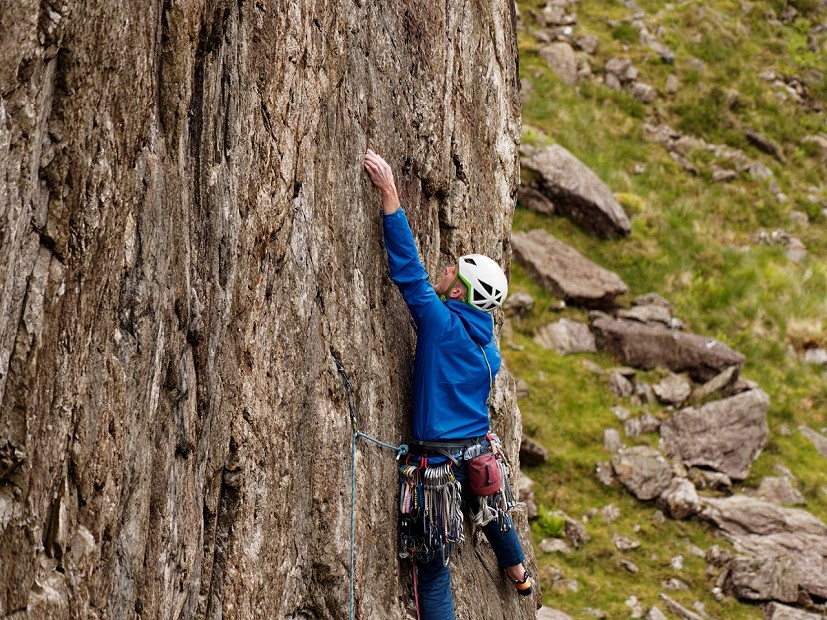
I have no issue with the cut in the arms which taper down to the wrists and don't feel overly flappy in any region. The underarms are shaped well to stop much hem lift when climbing or scrambling.
Fabric
The ripstop 'fishnet' nylon feels pretty durable for the weight and at 30D, it's one of the higher denier fabrics on review. The Etherlite feels like a jacket that I can continue to throw on throughout the day and not be overly worried about a lot of wear on the fabric. Unlike many of the others on review, I have had no worry using this for climbing in the hills where scuffs and wear are more likely, although I would still avoid using it in the likes of a chimney.
If running, breathability may be a slight issue in warmer temperatures, but overall I haven't found this to be a particularly sweaty or clammy jacket when working hard on a cool day. The fabric is also 100% recycled and can continue to be recycled after use.
Features
The hood is slightly elasticated around the brim and is a good fit to my head. This is lucky, since the close fit does help reduce flapping or the hood acting like a sail in the breeze. It's not adjustable for size however, and with no drawcord it's not going to fare particularly well in really windy conditions.
For maintaining appropriate airflow, the full-length zip provides better adjustment than a smock style jacket. The hem drawcord is kept thin and lightweight although this has come at the cost of effectiveness as I've found it can slowly come loose during use.
Unlike other jackets on review there are two hand warmer pockets. While lower pockets are not something that you would need when running or with a harness over the top, they definitely make the Etherlite feel like that bit more of a versatile jacket than much of the competition, and they're nice to have when standing about in cool conditions.
View websitesoftshell

A "long-sleeved t-shirt with attitude", this light, stretchy and breathable mountain top has found a niche in his wardrobe that Dan Bailey didn't know he needed to fill. Shame about the cut, he says.
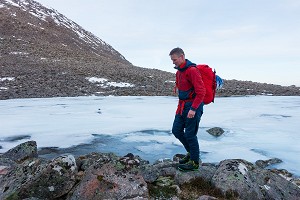

Quick-drying, breathable, and very warm for their minimal weight, these lined softshells make a great top-and-bottom combination for active use in winter mountains, says Dan Bailey.


"The pockets are large enough for a bottle of wine in each, and can still be accessed when wearing a climbing harness..." Fliss Freeborn and Lewis Mulholland get their priorities in order, in a review of these weather-resistant...


Technical mountain jackets are great in their place, but if you're just out for a walk in chilly autumn or winter...


Lightweight, quick-drying, and really breathable on the move, the collared version of this popular lined...


With a robust softshell fabric that combines a weather-resisting face with a snug furry inside, the Krypton works as either a...


This lined softshell is a versatile and lightweight do-it-all layer for walkers and climbers, reckons long-term Driclime fan...






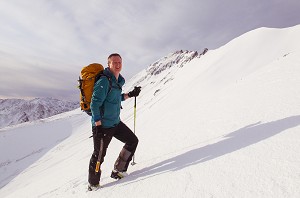


Comments
With these articles with lots of cool photos, would you be able to add more location details/link the image to climbing routes?
There are usually some great looking locations/routes (first one from Dan, first from Martin, a few more from Dan (Scotland just generally looks great!)) and it's tricky to work out where they actually are!
Hi Ed,
Thanks for that.
We'd like to add location details but there's so much info to convey already and pic captions only have limited size, so it does generally fall down the priority list in gear reviews!
First photo in the intro is on the slabs leading to the N.Ridge of Spidean Coire nan Clach (Beinn Eighe). Details in this route card: https://www.ukhillwalking.com/logbook/r/?i=1376
The first actual climbing pic in the intro (third photo) is John McKenna on 'The Star of Abu Judaidah' in Barrah Canyon, Wadi Rum
Cheers
Cheers Dan. I suspected that might be the case! Will check out the route card.
And me climbing in the Dynastar top - maintaining my rep as the review team's pet punter - I'm seconding a mod at Windgather Rocks, the spiritual home of the Peak District punter. :-) In my slight defence, I am wearing my trainers, it was rather straightforward, I had soloed it previously and my cousin Paul (who took the photos!) had just led it as his first ever route on his second ever time outside climbing, which was cool.
I've only rarely used my windshirt hoods but the one time I have used the one on my aerofoil it was very welcome over a light hooded fleece.
(A miserable 'Spring' morning in the N Pennines!).